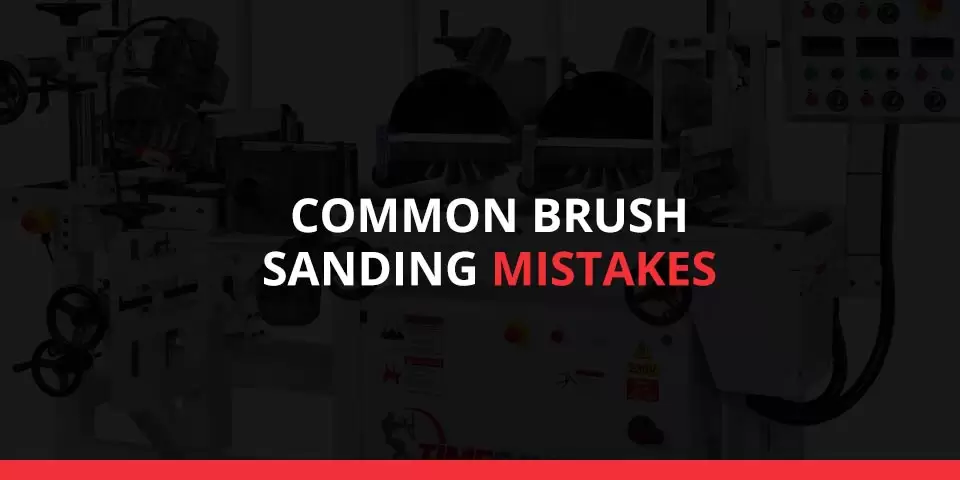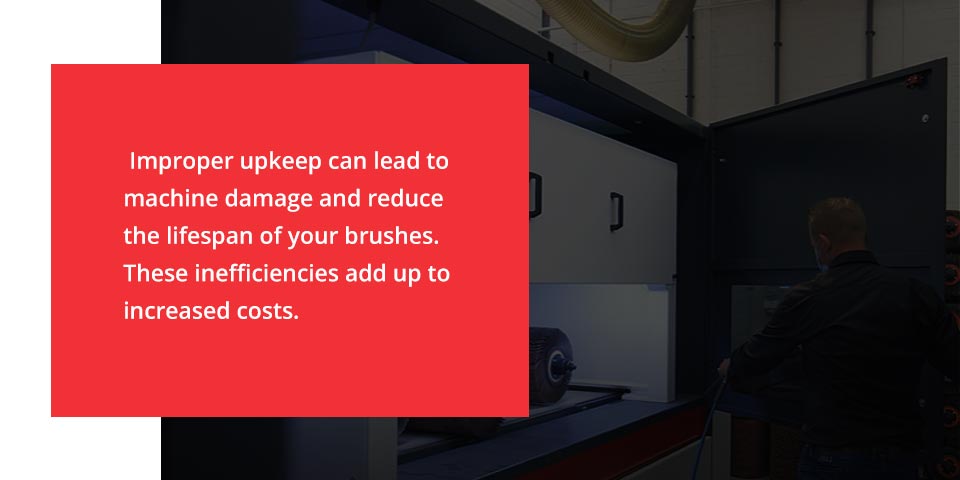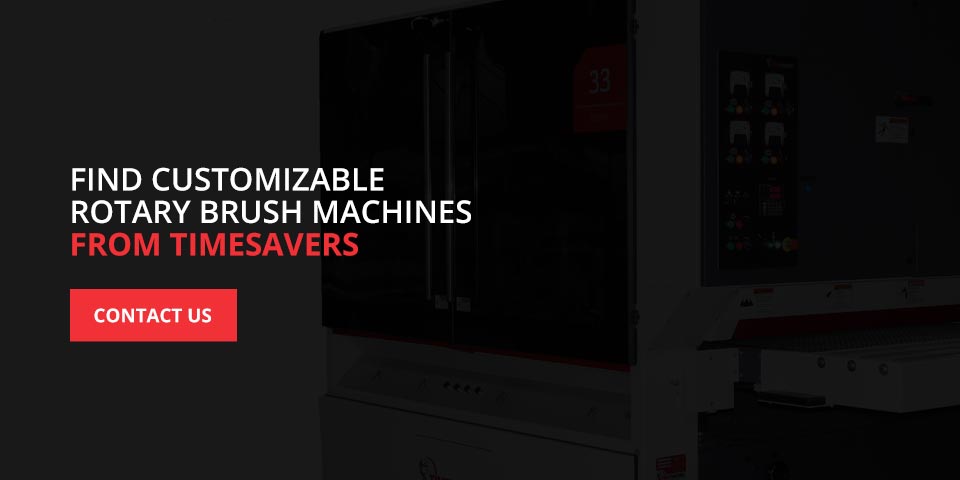Common Brush Sanding Mistakes

Rotary brush machines are important pieces of equipment in manufacturing facilities, providing uniform finishing to create high-quality metal and wood products. From deburring and edge finishing to slag and laser oxide removal, rotary brush machines are one of the most versatile pieces of equipment in the production line.
However, some common brush sanding mistakes can result in sub-optimal performance and costly damage to your metal and wood workpieces. These mistakes cost your manufacturing facility time and money and decrease efficiency. Learn how to properly use your operation’s industrial rotary brush machine to reap the benefits and ensure the highest quality results.
Using the Wrong Machine for the Job
Rotary brush machines are not one-size-fits-all. While some manufacturers may use the same wire brush sander for every job, the wide range of products being manufactured today require more specialized tools. Your manufacturing business needs machinery that meets the unique needs of its products to achieve the best results. It’s essential to select the brushes and wires that suit your workpieces and their characteristics. Using the right equipment for the task can help prevent machine malfunction, reduce workpiece damage and improve efficiency.
Depending on the material, there are several types of brushes and wires that can provide the finish you need. For example, a rotary brush machine for metal workpieces likely needs a brush specifically designed for each material. Thoroughly research the types of brushes available and test different styles with your wire brush sander to determine the best fit for your production needs. The main types of wire brushes include:
- Wire wheel brushes: These brushes are shaped like flat wheels with brush wires fanning out from the outer edge. The width of wire wheel brushes is less than their diameter. These brushes are highly versatile.
- Cylindrical brushes: As their name implies, cylindrical brushes are shaped like a cylinder, with brush filaments all around the outside. These brushes include a shaft or bore through the center, which attaches to the automatic wire brush machine during operation.
- Cup brushes: This style of wire brush is shaped like a circle, with the shaft on one side and the brush filaments on the opposite side. Cup brushes provide a larger contact area with the workpiece.
Besides selecting the right brush for the job, your production line may also benefit from customized industrial rotary brush machines. Whether you need a metal brushing or woodworking wire brush machine, utilizing equipment customized to your application’s specifications can enable greater efficiency and cost savings.

Poor Upkeep/Maintenance Habits
Failing to follow the proper upkeep schedule for your metal or wood brushing machine is one of the most common brush sanding mistakes and can cause other problems later on. Improper upkeep can lead to machine damage and reduce the lifespan of your brushes. These inefficiencies add up to increased costs.
Proper industrial rotary brush machine maintenance is vital for keeping machine components in top shape. Operators should perform daily maintenance and more intensive maintenance every three months.
Implement the following steps in your rotary brush machine maintenance routine to prevent some of the most common issues that result from poor upkeep:
Check for Damaged or Thrown Wires
Brushes may sometimes throw a wire or become damaged when the wrong brush is used for the job. Brush wires may also bend if the machine applies too much force to the workpiece. If too many brush wires break or bend, the brush could become misaligned and thrown out of balance, damaging the workpiece. Check brushes regularly for damaged or thrown wires and replace them if needed.
Examine Brushes for Wear and Tear
Excessive wear and tear to the wire brush machine’s brushes can damage the machine and pose a safety hazard for the operator. For example, if brush wires break off and fly off the wheel, they could injure operators or disrupt the machine’s operation.
Inspect brush wires regularly for bending, breakage or other signs of damage. Replace brushes once they exhibit any damage. Ensuring you’re using the right brush and cleaning the brushes and brush shaft using a cloth can also help prevent wire damage.
Use a High-Quality Product
A poor-quality industrial rotary machine could also lead to unnecessary wear and tear on your brushes and reduce their lifespan. Ensure you use a high-quality product and that you use it correctly every time. While higher-quality products may be a greater investment, the end result is better performance.
Confusing Brush Sanding With Orbital Sanding
When it comes to brush sanding vs. orbital sanding, understanding the difference is vital. These two techniques are best suited for different applications, and using orbital sanding when brush sanding would produce better results can lead to inefficiency in the production process.
Orbital Sanding
Industrial orbital sanding machines are complex and involve many moving parts. The main feature of an orbital sanding machine is its multiple heads that sand by working in small orbits. These heads remain mostly stationary during operation. Orbital sanding machines are designed to remove straight-line scratches in wood surfaces that go against the grain without scratching the wood.
Ensuring flawless orbital sanding requires selecting the best industrial orbital sander for the application. Orbital sanding machines come in multiple configurations, so manufacturers can select the best that best suits their application. Orbital sanders use automation to achieve a flawless finish on all kinds of woodworking projects, from cabinet- and furniture-making to flooring production.
Brush Sanding
Although brush sanding machines are also effective in a range of woodworking applications, they operate very differently from orbital sanding machines. A wood or metal brushing machine is very simple compared to orbital sanders. Whereas the orbital sanding machine’s heads remain stationary, a rotary brush machine rotates its brushes to deburr, remove laser oxide and round workpiece edges.
Brush sanding machines are not ideal for removing scratches in a workpiece because they are designed to move evenly over the entire surface of the workpiece, rounding edges and removing slag or laser oxide. The purpose of a brush sander is to control a workpiece’s final look and finish.

Find Customizable Rotary Brush Machines From Timesavers
Many brush sanding mistakes are easily fixed by selecting the right brushes and machine for the job, performing regular maintenance, and ensuring you use the right technique for each application.
When looking for brush sanding machine manufacturers, choose one that offers highly efficient machines and provides full customization to fit your needs. At Timesavers, our more than 75 years of experience serving the woodworking and metalworking industries lets us provide expert solutions for your business’s rotary brush machine needs. Timesavers offers complete machine customization to fill the requirements of your production line, workpieces and industry regulations.
Whatever industry you’re in or workpieces you work with, Timesavers has a machine that offers efficiency and accuracy while being fully compatible with your existing systems. Browse our rotary machines today or request your custom quote for one of our custom, industry-leading metal or wood finishing machines.
